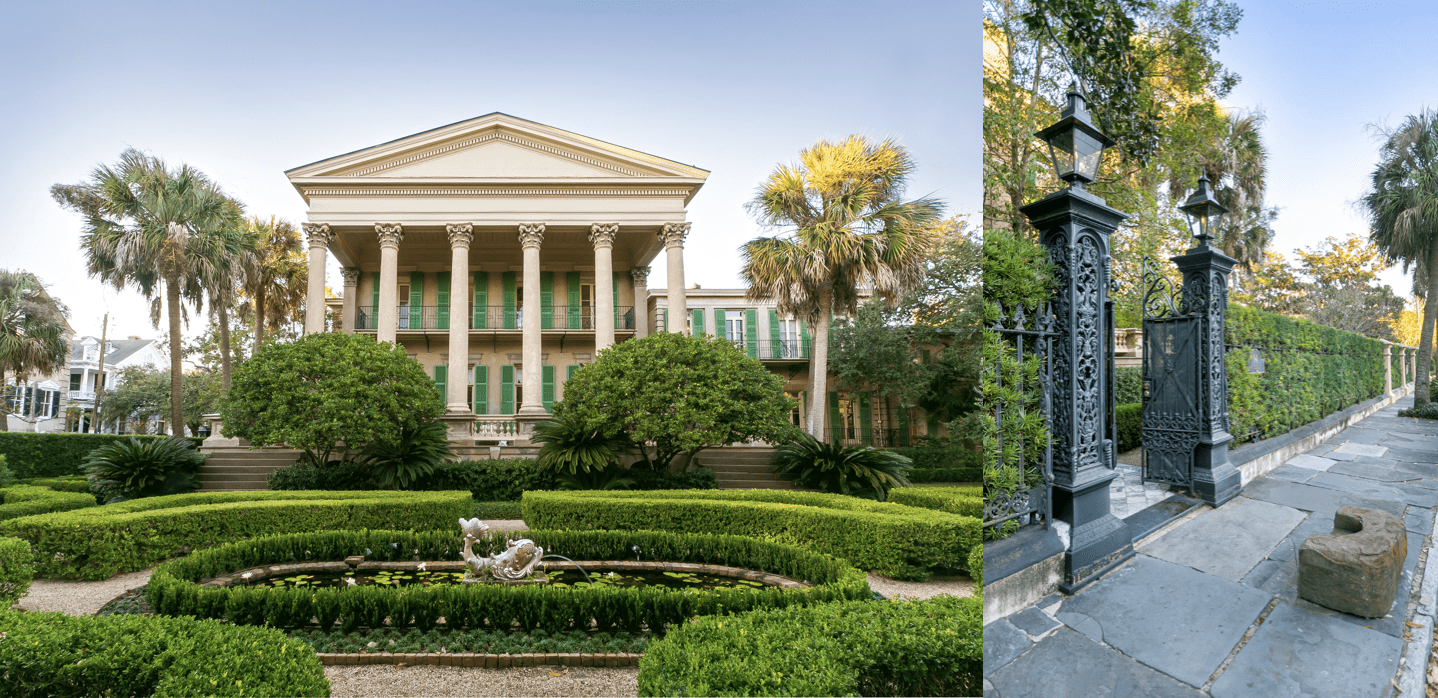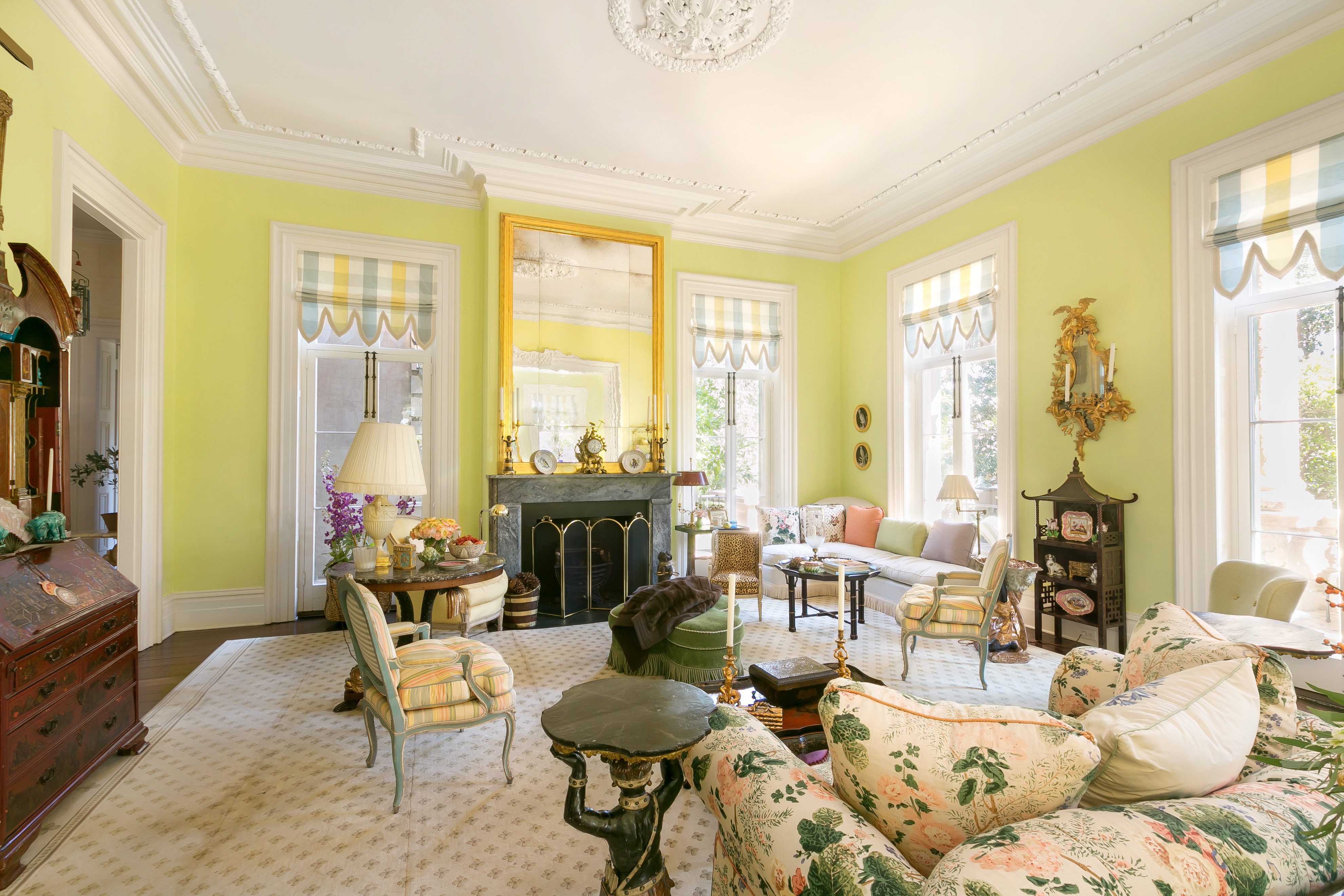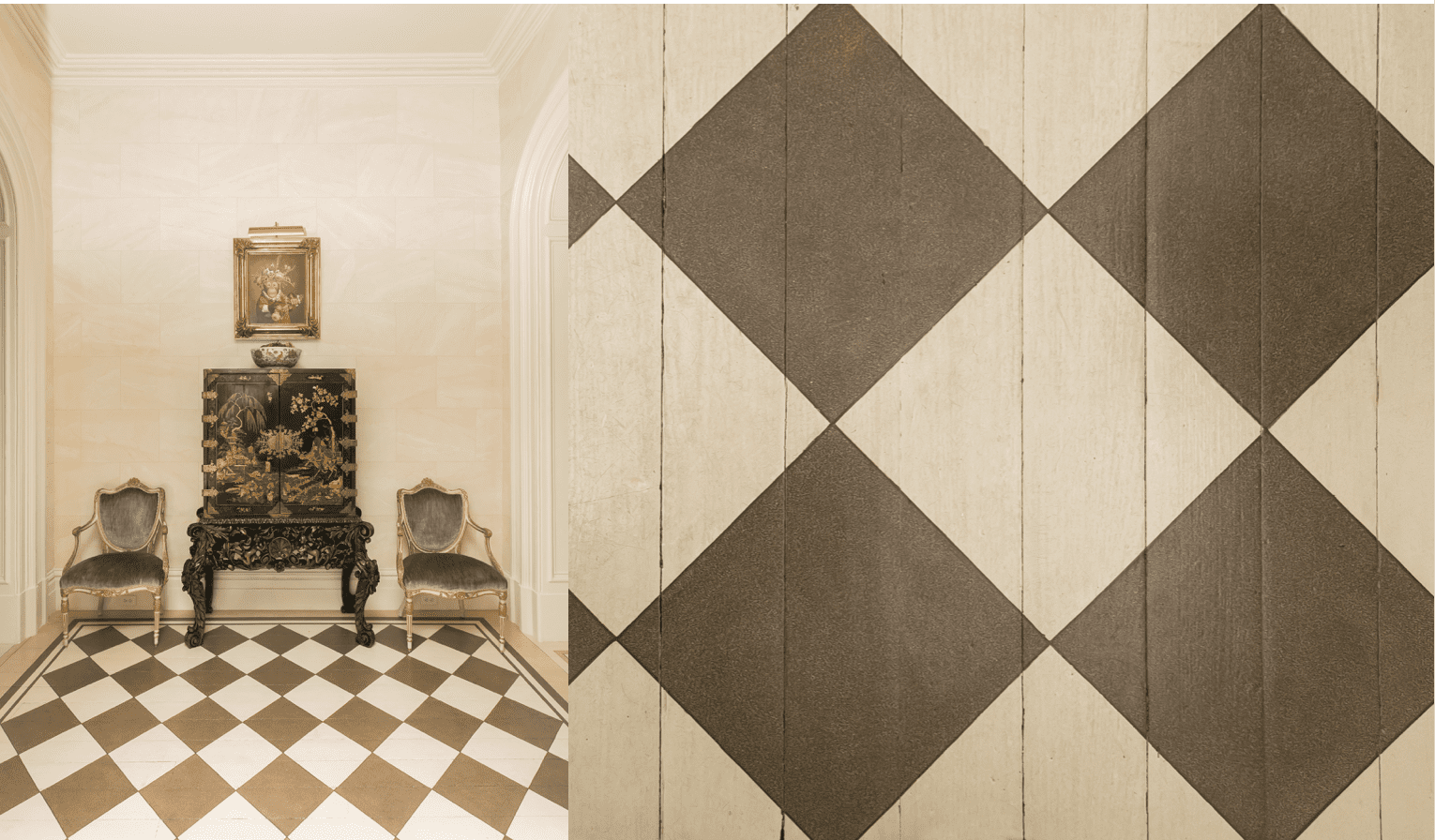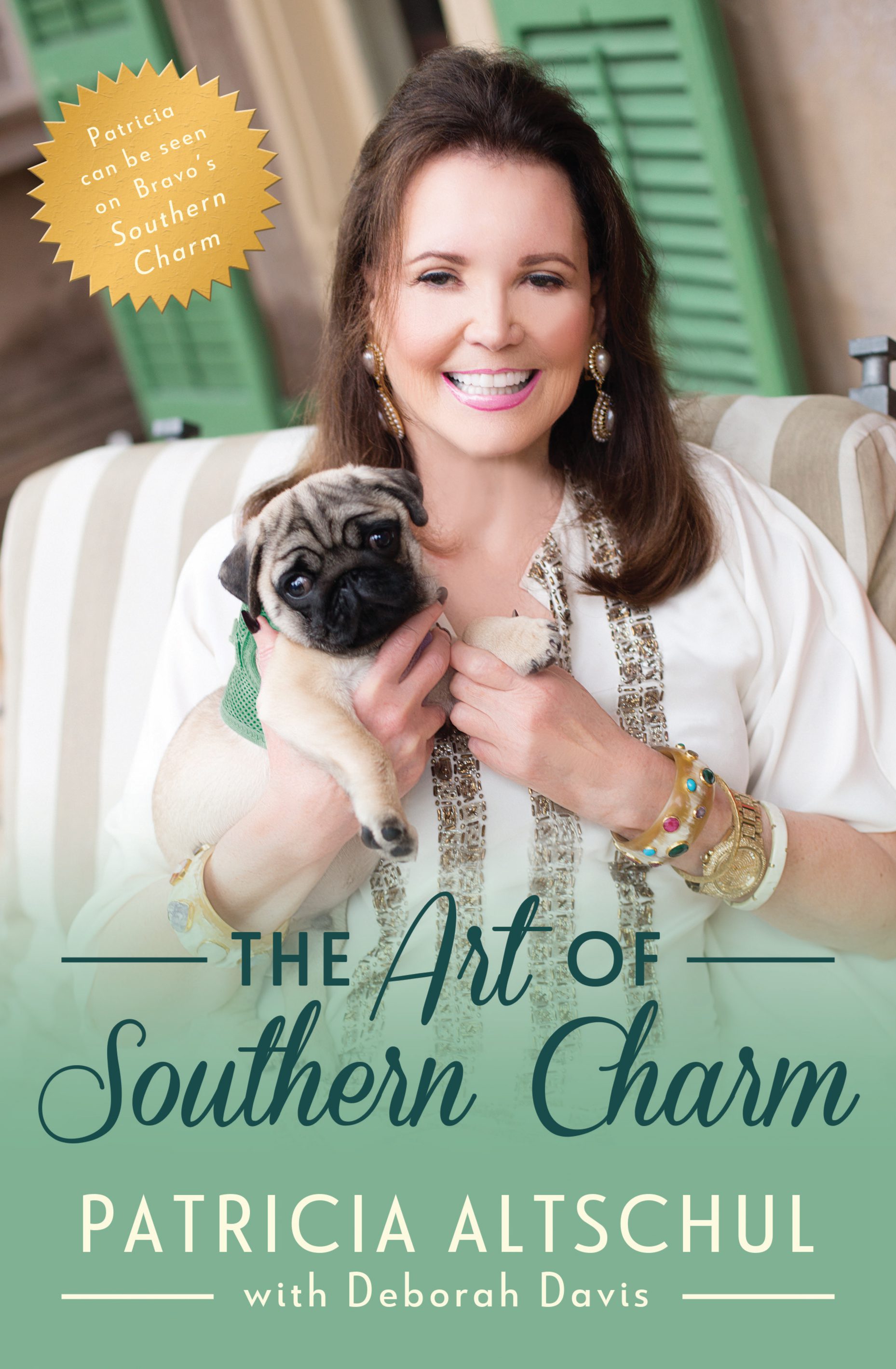
Once Patricia Altschul decided to get back to her southern roots, she set her sights on the Isaac Jenkins Mikell House. Find out more about this dynamic woman and the work that went into renovating her downtown Charleston mansion.
“Michael, it’s time for my medicine,” or “One cannot drink cheap wine in the heat,” represent only two of the many verbal gems that turned Patricia Altschul into a breakout star on Bravo’s Southern Charm. Long before her son, Whitney Sudler-Smith, created and produced the show that brought her wit to the masses, Patricia garnered a lot of respect and attention throughout the art world as well as many New York social circles and philanthropic realms. After concluding that the New York weather could no longer be tolerated, Patricia decided to move back down south and return to her roots. She purchased an 1854 home, which once served as the Charleston Free Library for nearly 30 years, that felt like the perfect place to settle into her new life in Charleston.
From the second Patricia blessed my television screen with her presence on Southern Charm, I put her on a pedestal. After sitting down and talking with her, I realized I was all wrong; the pedestal needed to be taller and needed a chintz-covered royal thrown on top of it for her to relax in while she sipped a martini. Her status hasn’t risen in my mind after seeing her lifestyle first hand; she elevated to a new level after sharing much of her life story, her successes, and experiencing how humble and kind she is. Patricia, and of course her butler Michael and pack of precious pups, were gracious enough to give a few of us at Charleston Home + Design magazine a personal tour of her downtown home and answer many questions about how she became the woman that she is today.
{For extra pictures of Patricia’s home not seen in the magazine, check out the gallery at the bottom of the blog!}

(Above) Patricia’s home is the Isaac Jenkins Mikell House, which once acted as the Charleston Free Library for nearly 30 years. Classic Charleston gas lamps anchor the iron gate to Patricia’s downtown mansion. High fences with thick greenery help provide a little privacy from the carriage ride tour groups that pass by daily to catch a glimpse of this stately abode.
I’m so excited to hear that you are a fellow Richmond, Virginia native. I’d love to hear about your life growing up in the Commonwealth.
My life in Virginia was like elsewhere in the 1950s. It was like Happy Days, Leave it to Beaver, or Father Knows Best. We would walk to places at night. We shopped in iconic Richmond department stores like Miller & Rhoads and Thalheimers. We would eat in the tearoom. Ladies and gentlemen would wear gloves. Montaldo’s was there, which was a very fancy dress shop. I remember when I was 16 or 17 my parents let me get a black dress for a party and I felt like the most sophisticated person in the world because nobody at that age had a dress from there. I don’t know why my parents let me, but I felt like a siren in my black dress. Of course, with it, I wore Mary Janes, pearls, and little white gloves.
All of that sounds so quintessentially Richmond!
Oh, yes! Very Richmond and I loved growing up there. We rode bicycles all over the city and went to Byrd Park. It was very relaxed, easy, fun, and safe. It was the last age of innocence in the 50s. It was nice growing up in Richmond.
I’ve read that education has been an important part of your life. Can you tell us a little bit more of how that track got started for you?
It started when I went to St. Catherine’s for just a minute. My parents quickly did not approve of St. Catherine’s. I came home one day and my parents asked me what I learned at school that day and I told them that I learned how to pour tea and we had elocution. There was very little academic concern at that school so my parents then enrolled me at Marymount. French nuns, who were very tough academically, ran this school and I was there until I graduated in the eighth grade. For high school, I was sent away to a Quaker boarding school. Also, I always went to riding camp in the Shenandoah Mountains.
That sounds like a great educational foundation. How did that impact you as you later went on to George Washington University?
The Quaker boarding school and French nuns gave me such a good education. I was studying physics, architectural history, and I had learned some Russian, so that by the time I got to George Washington (GW) I studied very hard, but it was easy for me. I graduated cum laude and I got a Smithsonian fellowship. I worked for Decorative Arts in the History and Technology Building. That started my love for the decorative arts as well as art history. While at GW, I earned a master’s degree in both Art History and Archaeology. Oh, and I was married the entire time I was doing all of this. I got married when I was 20.
How did you balance being a wife and being so successful and ambitious as a student?
My husband [L. Hayes Smith], who was about five years older, was already successful when I married him. He was the head of Dun & Bradstreet and had earned his MBA. I did a lot of the case studies for his business. At this time, I was in my academic period and I loved it. I had a good time doing everything. In addition, I had two houses that I ran. I did so by having other people manage everything so I could study. When it comes to domestic arts, I know how to do everything, and you can’t really run a house if you don’t personally know how things should be done, but I was not domestic. I still don’t like to cook. I can, but I don’t like to.
Sitting here in your stunning home, it is clear that you have wonderful taste. How did your education in art history and time at GW influence your design style and you in general?
The study influenced which periods of art I liked. I found that I liked the 19th century, up until 1960. When I started teaching at GW, they gave me the introductory courses, because I was still in graduate school. First, I was given all of the freshmen who were required to take Art 101, and then I taught the Survey of Western Art. After I taught for a while, they gave me Contemporary Art, which ended with the 60s, because well, we were in the 60s. Andy Warhol was kind of the end of contemporary art. It didn’t go any farther.
After teaching for so many years, I founded a company called Arcadia, Inc. I worked with a scholar and we were given the opportunity to build a collection of American, late 19th century art. My job was to go around to all of the different auctions, art galleries, and private dealers here and in Europe to find the paintings for this particular collection. After a while, other collectors and museums came to me to find things for them as well.
That sounds exciting and like a lot of fun. I know you didn’t keep this business going long-term. Did you have it when you transitioned to New York?
No, I remarried in 1989. I was living with my husband on his motor yacht and we went all over the world on that. I lost contact with people in the art world, and if you don’t keep up with it, you lose it. At the time, the Japanese were buying French Impressionists and that wasn’t my specialty, so I was happy for a rest. Whitney was away studying at that point; I think he was at Oxford when I got married. So, I basically closed down the company when I remarried. I was always on the board and I always looked for pieces for other people, but I just didn’t have a formal organization.

I’m sure letting go of the day-to-day business must’ve been difficult, but at least you were able to still stay involved in the art community. After stepping back, how did you dive back in again?
Well, I still kept up with my field and stayed involved more with that end. I continued to go to the auctions and would still buy and sell things at auction. I remarried [Arthur Altschul] in 1996. He was on the board of every major museum in New York. He actually started the Whitney Museum with Flora Biddle Whitney. He started almost all of the organizations at the Metropolitan Museum and he was always listed as one of the top 20 collectors in the United States. It was a great education for me and we had that in common. The years that we were together, we were all over the place going to auctions. It wouldn’t matter if it was Grosvenor House in London or a flea market; he was always on the hunt and it was great and really fun. I learned a lot from him.
That sounds like such an exciting life. You’ve said that you spent a lot of time at art auctions. What are they like and what sort of bidder are you? Are you ever an impulsive purchaser?
It’s funny you ask, because I bought something at auction while they were filming Southern Charm this season and I don’t know if they are going to use it or not. Anyway, you have to know what you’re doing when you bid at auction. I, first of all, have a definite taste of things that I like and collect. When I see something that I like, I call the auction house and speak to the curator of that department and I get a condition report and have a discussion about it. If I’m not in the place wherever I’m bidding, I do a phone bid, where they call me and I bid over the phone.
So it’s safe to say that impulse buying is not your style?
No. Well, at the grocery store, yes, but not at the auction house. I have gone over estimate before though.
What made you want to move back down south?
After Arthur died I lived in New York for six more years, but I missed the south and if you’re southern, it just kind of gets in your blood for whatever reason. So, I started looking. I had a great big house on Long Island, and it was wonderful in the summer, but in the winter it was cold and blustery and snowy and friends didn’t necessarily want to go out there.
It took me three years to find this house. I drove all over the south, or I would fly to various places with Mario Buatta, my decorator. We looked at various houses and, for whatever reason nothing felt right until we found this house and it just gelled. I had been down here to Charleston three times before to look at other houses, but I would drive by this one and tell the realtor that this is the type of house I’m looking for. So, when it came on the market I bought it immediately; I didn’t have any reservations.
Was your son, Whitney, always on board with your move to the Lowcountry?
[Laughs] People think Whitney lives with his mother wherever she is, but that is not the case. He has lived in L.A. since he graduated from college, so he would come and visit. I had an apartment in New York City for a while that he used more than I did. He likes it here, but he really lives and works in L.A.
I know you loved this house even before you stepped inside, but what drew you to the Holy City?
I think Charleston is the most beautiful American city that we have. With the architecture, the gardens, the ambiance, the people, the food, and being that close to the water, it has everything. I totally understand why it’s number one in the world. My New York friends, when I moved down here, thought it was all Honey Boo Boo and Gator Boys, because they had never been to the South. It amazed me because they had been to Burma and the Outer Hebrides, but never down south. So, when they came down to visit, they couldn’t get over how beautiful and sophisticated it was. Initially they said, “You’re going to be down there with earthquakes and hurricanes.” Since then, they have had two major
hurricanes in New York.
Over the years you’ve taken on several large home renovations and completed a lot of redecorating. Tell us a little bit about some of those endeavors and how you got started with Mario Buatta.
When I married Arthur, I lived in Washington and had a decorator. I was always geared towards the English country style. When I moved to New York, Arthur understood that since three other wives had decorated his apartment previously, I would want to redecorate it. I had a file this thick [holding her fingers a few inches apart] on Mario because for 15 years I had clipped his work out of the magazines that I subscribed to. One day I called up Mario and said, “I’m three blocks from you in a big apartment that is in a good building, but three wives have decorated it and I need your help desperately.” So, he came over and we hit it off. We’ve been really good friends ever since. Together, we’ve done four places: the apartment, Southerly, my apartment at 960, and now this. We’ve gone to auctions together, to Europe, and bought things at Christie’s.
I understand that you frequently turn to Mario, but would you say that there is a lot of your personal style in this home as well?
In the beginning of the remodel, I had an architect, Louis Graeber, and Mario who would come down every couple of months to work, and I also had Richard Marks Restoration, who was here everyday with 15 men. I came down from New York and put everything in storage and I was here with just my bed and a little table and chairs set. Michael then brought his stuff down and moved into the cottage. So, if they were working in one room, my bed was moved to other end of the house, so I just moved around based on where they were. I was here nearly every day and had my hand in everything. For the construction part, I corrected certain things or added ideas that I liked that weren’t in the original plans. For example, my library was their kitchen.
When you were restoring this house, how much of the history of the property did you have to pay attention to with the architecture and regulations?
Richard Marks was a member of The Historic Charleston Foundation, so he knew exactly what we could do and what we couldn’t do. The B.A.R. came over and there was one question about painting the banister. It had a lot of dark wood, but it was painted white, which is also very English. It was Cuban Mahogany so, they didn’t want me to paint it again, and in the end we compromised.
What was the one thing you had to have above all else when renovating this house?
Painted floors. Also, I wanted the entryway, bathroom, and the walls all painted with a faux marble finish. The crew had scaffolding here for four months because the marbling goes all the way up the stairs and down the hall. There were three people here doing the painting. It’s very pretty. They did a good job.

(Above) Careful craftsmanship went into this home renovation. Hand painted floors were one of Patricia’s must haves when putting her personal touch on this house. This hand painted work can be seen in the faux marbling on the walls as well. Patricia’s drawing rooms showcase many of her thoughtfully curated pieces of artwork and have been specifically staged and styled by her interior designer.
It depends on what I’m doing; I use the whole house. It looks like a big house, but every room is used. I entertain here [the drawing room], and when I’m on the house phone I go in the morning room. A lot of times when I’m reading, I’ll go in the library and have a cocktail in there. After dinner people go in there and have after dinner drinks and Whitney’s friends smoke cigars in there.
I’ve done some research on your collection of silhouettes that line the painted stairway; I understand you’ve inherited some, but could you tell me a little about that collection?
Yes, I did inherit some, and Arthur and I bought quite a few in our travels. It’s hard to find silhouettes that are more sophisticated; a lot of them are crudely done. Most of mine are European, and they’re reverse painting or cut silhouettes and some are on concave glass. I have one of George Washington that was the only one he actually sat for. There is also a Robert E. Lee silhouette that my second husband, who was a direct descendant, gave to me. I’ve gathered a lot of interesting ones. It’s kind of a fun thing because most people don’t collect them or care about them. One was made of Whitney, but he won’t let me hang it.
The work you’ve done on this home is stunning and you’ve filled it with museum quality pieces. What is next for you?
A lot. I’m always busy and looking for more things to do. Currently we are filming Southern Charm, so that is taking up a bit of time. I’ve started a caftan line, one of which I’m wearing now, that will be launching
soon. That whole endeavor is all very exciting. I’ve recently written a book that will be coming out in the near future, too. It’s titled “The Art of Southern Charm” and is a fun lifestyle guide.

Be sure to pre-order a copy of Patricia’s book, “The Art of Southern Charm,” on Amazon today!
